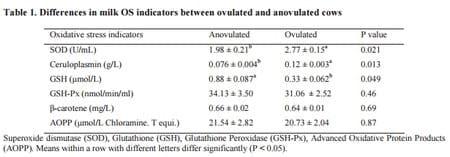Changes in Milk Oxidative Stress Biomarkers in Dairy Cows with Ovulatory and Anovulatory Oestrous Cycles
Published: March 30, 2015
By: S. Talukder A, K. L. Kerrisk A, G. Gabai B, A. Fukutomi A and P. Celi A (A Dairy Science Group, Faculty of Veterinary Science, The University of Sydney, Australia, B Dipartimento di Biomedicina Comparata e Alimentazione, Università `di Padova, Italy )
Oxidative stress (OS) can affect a variety of physiological functions in the female reproductive system (Celi, 2011). This study was conducted to evaluate changes in milk profiles of OS biomarkers in dairy cows with ovulatory and anovulatory oestrous cycles. Thirty (11 primiparous and 19 multiparous) healthy, lactating, cycling Holstein Friesian dairy cows averaging 60 ± 17 days in milk, and producing 33 ± 6 kg of milk per day (the week before commencing the study) were enrolled in this study. Composite milk samples were collected thrice weekly and assayed for progesterone (P4) concentration and the following OS biomarkers: superoxide dismutase (SOD), advanced oxidation protein products (AOPP), ceruloplasmin, glutathione (GSH), -carotene content and glutathione peroxidase (GSH-Px). Individual milk P4 profiles were constructed for each cow to characterise ovarian activity so that cows' oestrus cycles could be identified as ovulatory (n = 20) or anovulatory (n =10). Cows were assessed for body condition score (BCS) and locomotion score (LS) weekly. Differences in OS biomarkers were compared between two groups (ovulatory vs. anovulatory) using linear mixed models (LMM) with cow identification number being a random factor. A series of separate LMM were fitted to each of the OS biomarkers specifying the fixed effects of BCS, LS, lactation number, daily milk production, days in milk, and body weight.

Cows with ovulatory oestrous cycles presented significantly higher ceruloplasmin and SOD levels compared to cows that did not ovulate ((P = 0.013 and 0.021 respectively; Table 1). On the other hand, GSH concentrations were lower in ovulated cows (0.33 ± 0.27 mol/L) compared to the anovulated cows (0.88 ± 0.051 mol/L; P = 0.049; Table 1) in agreement with our previous findings (Talukder et al 2014). Cows with a locomotion score of 1.0 had significantly (P < 0.05) higher GSH-Px and SOD concentration compared to cows with a locomotion score of 1.5 (GSH-Px: 34.84 ± 0.79 vs. 31.27 ± 1.32 nmol/min/ml; SOD: 2.28 ± 0.12 vs 1.72 ±0.12 U/mL respectively). It could be postulated that the elevated level of milk SOD and ceruloplasmin in ovulating cows may be an essential event preceding the ovulatory response.
Celi, P. (2011). In: Oxidative Stress in Applied Basic Research and Clinical Practice, Studies in Veterinary Medicine, Vol 5 (Eds. L. Mandelker and P. Vajdovich) p. 191 (Humana Press).
Talukder, S., Kerrisk, K.L., Ingenhoff, L., Gabai, G., Garcia, S.C., Celi, P. (2014). Anim. Prod. Sci. (under review).
This work was supported by the Future Dairy project and The University of Sydney
Celi, P. (2011). In: Oxidative Stress in Applied Basic Research and Clinical Practice, Studies in Veterinary Medicine, Vol 5 (Eds. L. Mandelker and P. Vajdovich) p. 191 (Humana Press).
Talukder, S., Kerrisk, K.L., Ingenhoff, L., Gabai, G., Garcia, S.C., Celi, P. (2014). Anim. Prod. Sci. (under review).
This work was supported by the Future Dairy project and The University of Sydney
Content from the event:
Related topics:
Authors:
The University of Sydney
The University of Sydney
Recommend
Comment
Share

Would you like to discuss another topic? Create a new post to engage with experts in the community.






